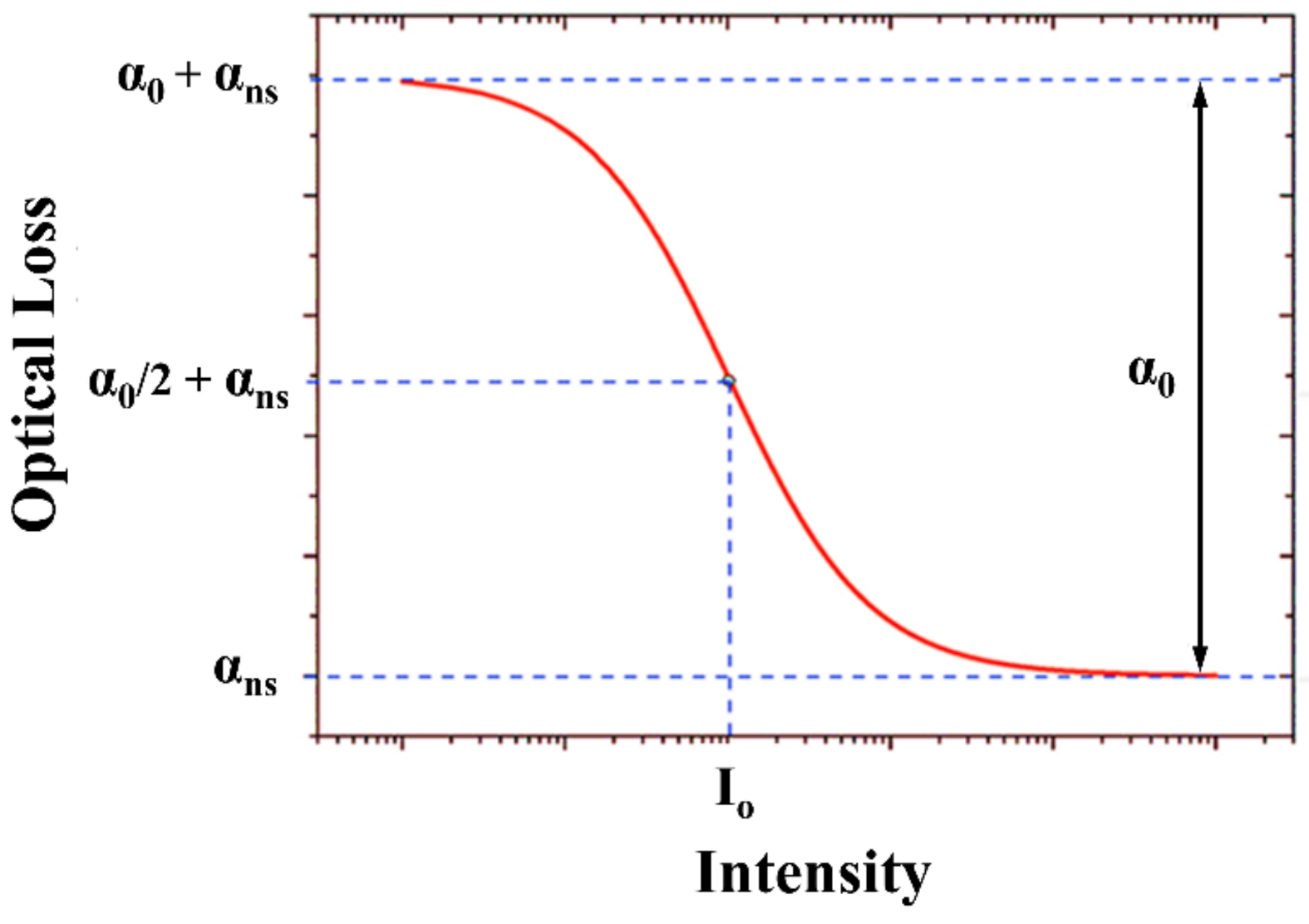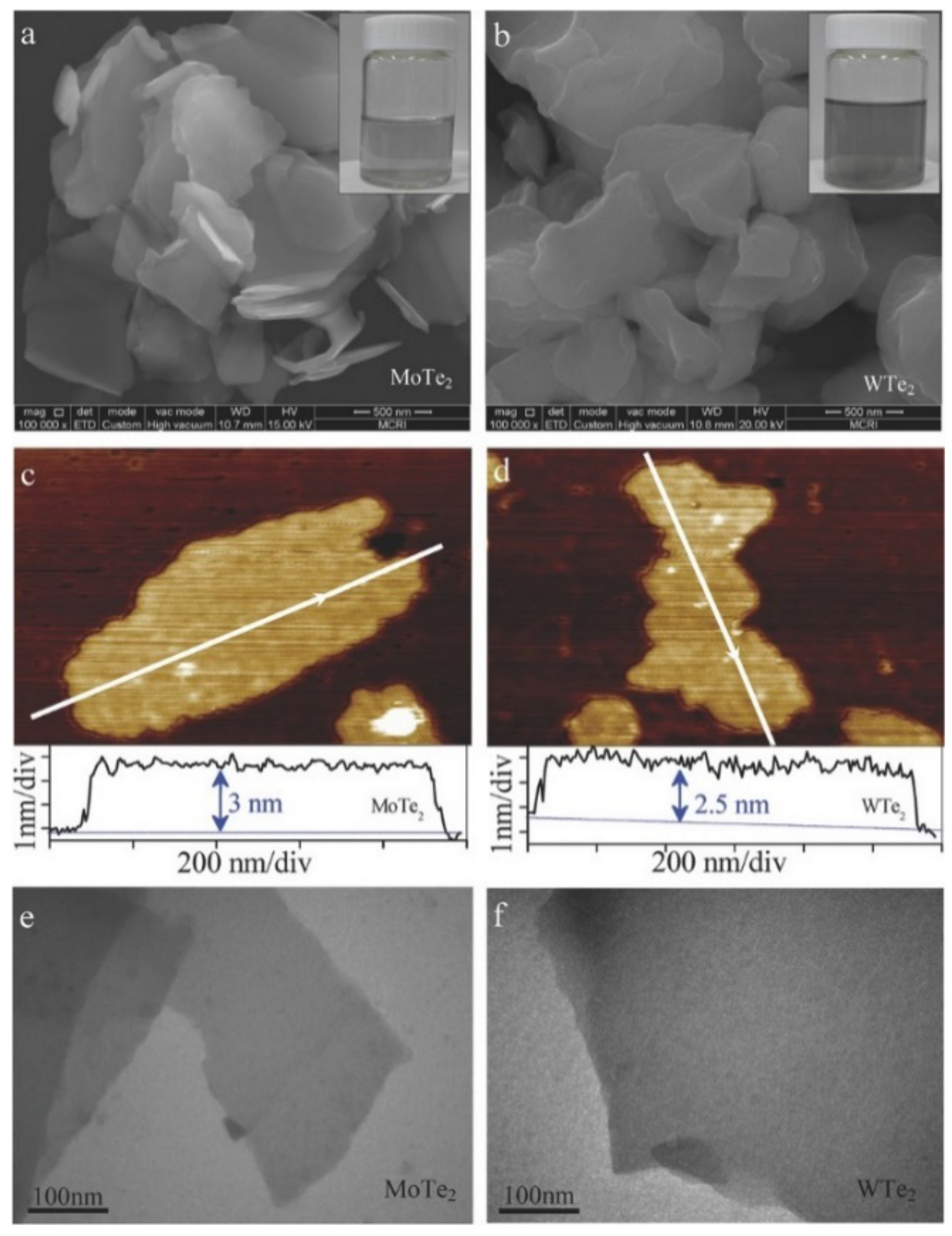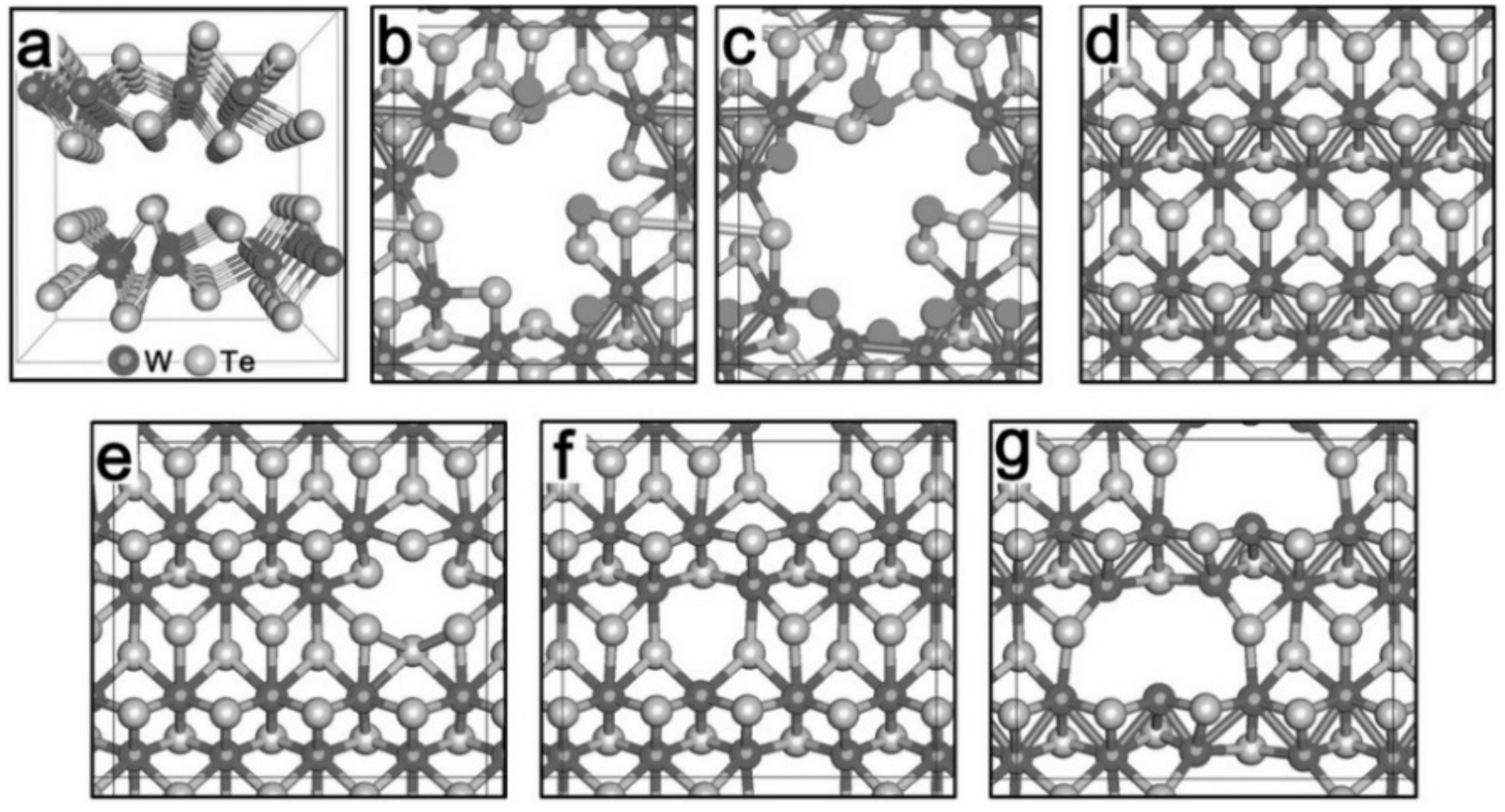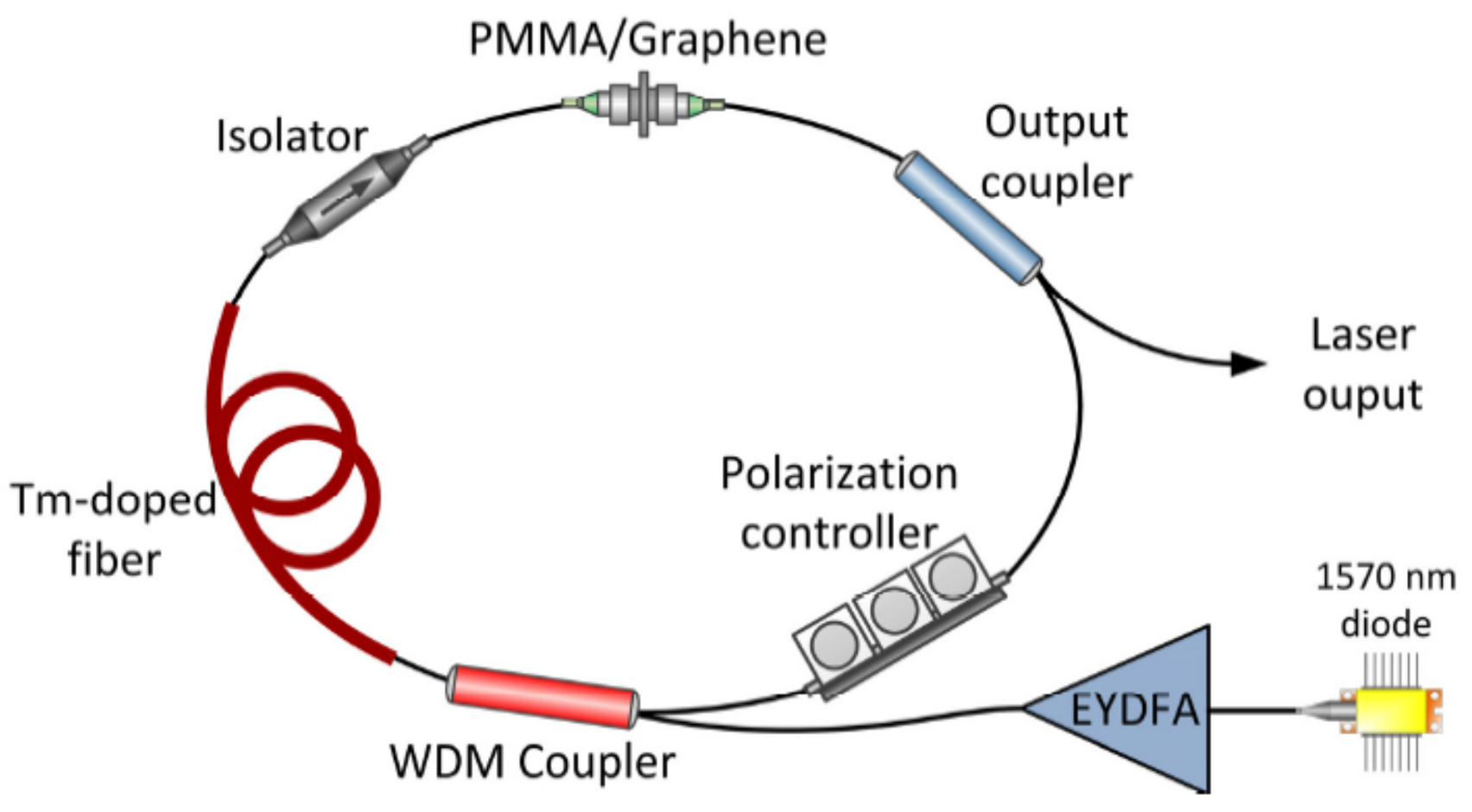Saturable Absorption Dynamics of Highly Stacked 2D Materials for Ultrafast Pulsed Laser Production
Abstract
1. Introduction
2. Saturable Absorption and Mode Locking
3. Transition Metal Dichalcogenide SAs
3.1. Few-Layered MoTe2/WTe2 SAs
3.2. Highly Staked MoTe2/WTe2 SAs
4. Topological Insulator SAs
4.1. Highly Stacked Bi2Te3 SAs
4.2. TI SAs for Dissipative Soliton Resonance Lasers
5. Graphene and Graphite SAs
5.1. Graphene SAs
5.2. Graphite SAs
6. Perspective of 2D Material SAs
Author Contributions
Funding
Institutional Review Board Statement
Informed Consent Statement
Data Availability Statement
Conflicts of Interest
References
- Boyd, R.W. Nonlinear Optics, 3rd ed.; Academic Press: Cambridge, MA, USA, 2008. [Google Scholar]
- Franken, P.A.; Hill, A.E.; Peters, C.W.; Weinreich, G. Generation of optical harmonics. Phys. Rev. Lett. 1961, 7, 118–119. [Google Scholar] [CrossRef]
- Kerr, J. XL. A new relation between electricity and light: Dielectrified media birefringent. Lond. Edinb. Dubl. Philos. Mag. J. Sci. 1875, 50, 337–348. [Google Scholar] [CrossRef]
- Bass, M.; Franken, P.A.; Ward, J.F.; Weinreich, G. Optical rectification. Phys. Rev. Lett. 1962, 9, 446–448. [Google Scholar] [CrossRef]
- Colin, S.; Contesse, E.; Le Boudec, P.; Stephan, G.; Sanchez, F. Evidence of a saturable-absorption effect in heavily erbium-doped fibers. Opt. Lett. 1996, 21, 1987–1989. [Google Scholar] [CrossRef] [PubMed]
- Keller, U. Recent developments in compact ultrafast lasers. Nature 2003, 424, 831–838. [Google Scholar] [CrossRef] [PubMed]
- Jiang, T.; Xu, Y.; Tian, Q.; Liu, L.; Kang, Z.; Yang, R.; Qin, G.; Qin, W. Passively Q-switching induced by gold nanocrystals. Appl. Phys. Lett. 2012, 101, 151122. [Google Scholar] [CrossRef]
- Weigand, R.; Balmaseda, M.; Pérez, J. Q-switched operation with carbon-based saturable absorbers in a Nd:YLF Laser. Appl. Sci. 2015, 5, 566–574. [Google Scholar] [CrossRef]
- Jhon, Y.I.; Kim, C.; Seo, M.; Cho, W.J.; Lee, S.; Jhon, Y.M. Tensile characterization of single-walled carbon nanotubes with helical structural defects. Sci. Rep. 2016, 6, 20324. [Google Scholar] [CrossRef] [PubMed]
- Wang, J.; Hernandez, Y.; Lotya, M.; Coleman, J.N.; Blau, W.J. Broadband nonlinear optical response of graphene dispersions. Adv. Mater. 2009, 21, 2430–2435. [Google Scholar] [CrossRef]
- Qiao, J.; Sung, W.H.; Lan, J.C.; Lin, Y.Y.; Wu, M.Y.; Fan, R.; Li, Y.; Qiao, W.; Liu, H.; Zhao, S.; et al. Are graphene-Bi2Te3van der Waals heterostructure-based saturable absorbers promising for solid-state Q-switched lasers? Opt. Lett. 2019, 44, 1072. [Google Scholar] [CrossRef]
- Choi, W.; Choudhary, N.; Han, G.H.; Park, J.; Akinwande, D.; Lee, Y.H. Recent development of two-dimensional transition metal dichalcogenides and their applications. Mater. Today 2017, 20, 116–130. [Google Scholar] [CrossRef]
- Kou, L.; Ma, Y.; Sun, Z.; Heine, T.; Chen, C. Two-dimensional topological insulators: Progress and prospects. J. Phys. Chem. Lett. 2017, 8, 1905–1919. [Google Scholar] [CrossRef]
- Liu, H.; Neal, A.T.; Zhu, Z.; Luo, Z.; Xu, X.; Tománek, D.; Ye, P.D. Phosphorene: An unexplored 2D semiconductor with a high hole mobility. ACS Nano 2014, 8, 4033–4041. [Google Scholar] [CrossRef] [PubMed]
- Anasori, B.; Lukatskaya, M.R.; Gogotsi, Y. 2D metal carbides and nitrides (MXenes) for energy storage. Nat. Rev. Mater. 2017, 2, 16098. [Google Scholar] [CrossRef]
- Jhon, Y.I.; Seo, M.; Jhon, Y.M. First-principles study of a MXene terahertz detector. Nanoscale 2018, 10, 69–75. [Google Scholar] [CrossRef]
- Jhon, Y.I.; Jhon, Y.M.; Lee, J.H. Nonlinear optics of MXene in laser technologies. J. Phys. Mater. 2020, 3, 032004. [Google Scholar] [CrossRef]
- Jhon, Y.I.; Jhon, Y.M.; Lee, J.H. Broadband ultrafast photonics of two-dimensional transition metal carbides (MXenes). Nano Futures 2020, 4, 032003. [Google Scholar] [CrossRef]
- Li, Y.; Dong, N.; Zhang, S.; Zhang, X.; Feng, Y.; Wang, K.; Zhang, L.; Wang, J. Giant two-photon absorption in monolayer MoS2. Laser Photonics Rev. 2015, 9, 427–434. [Google Scholar] [CrossRef]
- Lin, Y.Y.; Song, W.H.; Lee, P.; Wang, Y.R.; Zhang, H.; Lee, C.K. Dynamic cavity effects in topological insulator Bi2Te3 based passive Q-switched solid state laser. J. Phys. Commun. 2018, 2, 125007. [Google Scholar] [CrossRef]
- Jhon, Y.I.; Zhu, S.E.; Ahn, J.H.; Jhon, M.S. The mechanical responses of tilted and non-tilted grain boundaries in graphene. Carbon 2012, 50, 3708–3716. [Google Scholar] [CrossRef]
- Jhon, Y.I.; Jhon, Y.M.; Yeom, G.Y.; Jhon, M.S. Orientation dependence of the fracture behavior of graphene. Carbon 2014, 66, 619–628. [Google Scholar] [CrossRef]
- Lee, C.; Wei, X.; Kysar, J.W.; Hone, J. Measurement of the Elastic Properties and Intrinsic Strength of Monolayer Graphene. Science 2008, 321, 385–388. [Google Scholar] [CrossRef]
- Cohen-Tanugi, D.; Grossman, J.C. Water Desalination across Nanoporous Graphene. Nano Lett. 2012, 12, 3602–3608. [Google Scholar] [CrossRef]
- Jhon, Y.I.; Kim, C.; Byun, Y.T.; Lee, J.H.; Jhon, Y.M. Facile large-area fabrication of highly selective and permeable few-layered graphene: A molecular dynamics study. Carbon 2019, 155, 369–378. [Google Scholar] [CrossRef]
- Kim, Y.; Jhon, Y.I.; Park, J.; Kim, C.; Lee, S.; Jhon, Y.M. Plasma functionalization for cyclic transition between neutral and charged excitons in monolayer MoS2. Sci. Rep. 2016, 6, 21405. [Google Scholar] [CrossRef] [PubMed]
- Jhon, Y.I.; Kim, Y.; Park, J.; Kim, J.H.; Lee, T.; Seo, M.; Jhon, Y.M. Significant exciton brightening in monolayer tungsten disulfides via fluorination: N-type gas sensing semiconductors. Adv. Funct. Mater. 2016, 26, 7551–7559. [Google Scholar] [CrossRef]
- Chaves, A.; Azadani, J.G.; Alsalman, H.; da Costa, D.R.; Frisenda, R.; Chaves, A.J.; Song, S.H.; Kim, Y.D.; He, D.; Zhou, J.; et al. Bandgap engineering of two-dimensional semiconductor materials. Npj 2D Mater. Appl. 2020, 4, 29. [Google Scholar] [CrossRef]
- Jhon, Y.I.; Koo, J.; Anasori, B.; Seo, M.; Lee, J.H.; Gogotsi, Y.; Jhon, Y.M. Metallic MXene saturable absorber for femtosecond mode-locked lasers. Adv. Mater. 2017, 29, 1702496. [Google Scholar] [CrossRef]
- Liu, H.; Zheng, X.W.; Liu, M.; Zhao, N.; Luo, A.P.; Luo, Z.C.; Xu, W.C.; Zhang, H.; Zhao, C.J.; Wen, S.C. Femtosecond pulse generation from a topological insulator mode-locked fiber laser. Opt. Express 2014, 22, 6868. [Google Scholar] [CrossRef]
- Jhon, Y.I.; Lee, J.; Jhon, Y.M.; Lee, J.H. Topological insulators for mode-locking of 2-μm fiber lasers. IEEE J. Sel. Top. Quantum Electron. 2018, 24, 110220. [Google Scholar] [CrossRef]
- Jhon, Y.I.; Lee, J.; Seo, M.; Lee, J.H.; Jhon, Y.M. Van der Waals layered tin selenide as highly nonlinear ultrafast saturable absorber. Adv. Opt. Mater. 2019, 7, 1801745. [Google Scholar] [CrossRef]
- Koo, J.; Jhon, Y.I.; Park, J.; Lee, J.; Jhon, Y.M.; Lee, J.H. Near-infrared saturable absorption of defective Bulk-structured Wte2for femtosecond laser mode-locking. Adv. Funct. Mater. 2016, 26, 7454–7461. [Google Scholar] [CrossRef]
- Sobon, G.; Sotor, J.; Abramski, K.M. All-polarization maintaining femtosecond Er-doped fiber laser mode-locked by graphene saturable absorber. Laser Phys. Lett. 2012, 9, 581–586. [Google Scholar] [CrossRef]
- Lee, J.; Koo, J.; Debnath, P.; Song, Y.W.; Lee, J.H. AQ-switched, mode-locked fiber laser using a graphene oxide-based polarization sensitive saturable absorber. Laser Phys. Lett. 2013, 10, 035103. [Google Scholar] [CrossRef]
- Boguslawski, J.; Sotor, J.; Sobon, G.; Tarka, J.; Jagiello, J.; Macherzynski, W.; Lipinska, L.; Abramski, K.M. Mode-locked Er-doped fiber laser based on liquid phase exfoliated Sb2Te3 topological insulator. Laser Phys. 2014, 24, 105111. [Google Scholar] [CrossRef]
- Chen, Y.; Jiang, G.; Chen, S.; Guo, Z.; Yu, X.; Zhao, C.; Zhang, H.; Bao, Q.; Wen, S.; Tang, D.; et al. Mechanically exfoliated black phosphorus as a new saturable absorber for both Q-switching and mode-locking laser operation. Opt. Express 2015, 23, 12823. [Google Scholar] [CrossRef]
- Liu, H.; Luo, A.P.; Wang, F.Z.; Tang, R.; Liu, M.; Luo, Z.C.; Xu, W.C.; Zhao, C.J.; Zhang, H. Femtosecond pulse erbium-doped fiber laser by a few-layer MoS2 saturable absorber. Opt. Lett. 2014, 39, 4591. [Google Scholar] [CrossRef]
- Li, Z.; Pang, C.; Li, R.; Chen, F. Low-dimensional materials as saturable absorbers for pulsed waveguide lasers. J. Phys. Photon. 2020, 2, 031001. [Google Scholar] [CrossRef]
- Wu, K.; Zhang, X.; Wang, J.; Li, X.; Chen, J. WS2 as a saturable absorber for ultrafast photonic applications of mode-locked and Q-switched lasers. Opt. Express 2015, 23, 11453. [Google Scholar] [CrossRef] [PubMed]
- Mao, D.; Wang, Y.; Ma, C.; Han, L.; Jiang, B.; Gan, X.; Hua, S.; Zhang, W.; Mei, T.; Zhao, J. WS2 mode-locked ultrafast fiber laser. Sci. Rep. 2015, 5, 7965. [Google Scholar] [CrossRef]
- Khazaeinezhad, R.; Kassani, S.H.; Jeong, H.; Park, K.J.; Kim, B.Y.; Yeom, D.I.; Oh, K. Ultrafast pulsed all-fiber laser Based on tapered fiber enclosed by few-layer WS 2 nanosheets. IEEE Photonics Technol. Lett. 2015, 27, 1581–1584. [Google Scholar] [CrossRef]
- Luo, Z.; Li, Y.; Zhong, M.; Huang, Y.; Wan, X.; Peng, J.; Weng, J. Nonlinear optical absorption of few-layer molybdenum diselenide (MoSe2) for passively mode-locked soliton fiber laser. Photonics Res. 2015, 3, A79–A86. [Google Scholar] [CrossRef]
- Shang, C.; Zhang, Y.; Qin, H.; He, B.; Zhang, C.; Sun, J.; Li, J.; Ma, J.; Ji, X.; Xu, L.; et al. Review on wavelength-tunable pulsed fiber lasers based on 2D materials. Opt. Laser Technol. 2020, 131, 106375. [Google Scholar] [CrossRef]
- Zhang, H.; Ma, P.; Zhu, M.; Zhang, W.; Wang, G.; Fu, S. Palladium selenide as a broadband saturable absorber for ultra-fast photonics. Nanophotonics 2020, 9, 2557–2567. [Google Scholar] [CrossRef]
- Xu, N.; Ma, P.; Fu, S.; Shang, X.; Jiang, S.; Wang, S.; Li, D.; Zhang, H. Tellurene-based saturable absorber to demonstrate large-energy dissipative soliton and noise-like pulse generations. Nanophotonics 2020, 9, 2783–2795. [Google Scholar] [CrossRef]
- Mak, K.F.; Lee, C.; Hone, J.; Shan, J.; Heinz, T.F. Atomically thin MoS2: A new direct-gap semiconductor. Phys. Rev. Lett. 2010, 105, 136805. [Google Scholar] [CrossRef]
- Cong, C.; Shang, J.; Wu, X.; Cao, B.; Peimyoo, N.; Qiu, C.; Sun, L.; Yu, T. Synthesis and optical properties of large-area single-crystalline 2D semiconductor WS2 monolayer from chemical vapor deposition. Adv. Opt. Mater. 2013, 2, 131–136. [Google Scholar] [CrossRef]
- Mao, D.; Du, B.; Yang, D.; Zhang, S.; Wang, Y.; Zhang, W.; She, X.; Cheng, H.; Zeng, H.; Zhao, J. Nonlinear saturable absorption of liquid-exfoliated molybdenum/tungsten ditelluride nanosheets. Small 2016, 12, 1489–1497. [Google Scholar] [CrossRef]
- Huang, X.; Zeng, Z.; Zhang, H. Metal dichalcogenide nanosheets: Preparation, properties and applications. Chem. Soc. Rev. 2013, 42, 1934. [Google Scholar] [CrossRef] [PubMed]
- Zhang, M.; Howe, R.C.T.; Woodward, R.I.; Kelleher, E.J.R.; Torrisi, F.; Hu, G.; Popov, S.V.; Taylor, J.R.; Hasan, T. Solution processed MoS2-PVA composite for sub-bandgap mode-locking of a wideband tunable ultrafast Er:fiber laser. Nano Res. 2015, 8, 1522–1534. [Google Scholar] [CrossRef]
- Chen, Y.; Zhao, C.; Chen, S.; Du, J.; Tang, P.; Jiang, G.; Zhang, H.; Wen, S.; Tang, D. Large Energy, Wavelength Widely Tunable, Topological Insulator Q-Switched Erbium-Doped Fiber Laser. IEEE J. Sel. Top. Quantum Electron. 2014, 20, 315–322. [Google Scholar] [CrossRef]
- Lee, C.H.; Silva, E.C.; Calderin, L.; Nguyen, M.A.T.; Hollander, M.J.; Bersch, B.; Mallouk, T.E.; Robinson, J.A. Tungsten Ditelluride: A layered semimetal. Sci. Rep. 2015, 5, 10013. [Google Scholar] [CrossRef]
- Ali, M.N.; Xiong, J.; Flynn, S.; Tao, J.; Gibson, Q.D.; Schoop, L.M.; Liang, T.; Haldolaarachchige, N.; Hirschberger, M.; Ong, N.P.; et al. Large, non-saturating magnetoresistance in WTe2. Nature 2014, 514, 205–208. [Google Scholar] [CrossRef]
- Wang, Q.H.; Kalantar-Zadeh, K.; Kis, A.; Coleman, J.N.; Strano, M.S. Electronics and optoelectronics of two-dimensional transition metal dichalcogenides. Nat. Nanotechnol. 2012, 7, 699–712. [Google Scholar] [CrossRef]
- Scholle, K.; Lamrini, S.; Koopmann, P.; Fuhrberg, P. 2 µm laser sources and their possible applications. In Frontiers in Guided Wave Optics and Optoelectronics; Pal, B., Ed.; IntechOpen: London, UK, 2010; pp. 471–500. [Google Scholar]
- McAleavey, F.J.; O’Gorman, J.; Donegan, J.F.; MacCraith, B.D.; Hegarty, J.; Maze, G. Narrow linewidth, tunable Tm3+-doped fluoride fiber laser for optical-based hydrocarbon gas sensing. IEEE J. Sel. Top. Quantum Electron. 1997, 3, 1103–1111. [Google Scholar] [CrossRef]
- Ebrahim-Zadeh, M.; Sorokina, I.T. Mid-Infrared Coherent Sources and Applications; Springer: New York, NY, USA, 2008. [Google Scholar]
- Spiers, G.D.; Menzies, R.T.; Jacob, J.; Christensen, L.E.; Phillips, M.W.; Choi, Y.; Browell, E.V. Atmospheric CO2 measurements with a 2 μm airborne laser absorption spectrometer employing coherent detection. Appl. Opt. 2011, 50, 2098. [Google Scholar] [CrossRef]
- Henderson, S.W.; Suni, P.J.M.; Hale, C.P.; Hannon, S.M.; Magee, J.R.; Bruns, D.L.; Yuen, E.H. Coherent laser radar at 2 µm using solid-state lasers. IEEE Trans. Geosci. Remote Sens. 1993, 31, 4–15. [Google Scholar] [CrossRef]
- Bouma, B.E. Optical coherence tomographic imaging of human tissue at 1.55 μm and 1.81 μm using er-and tm-doped fiber sources. J. Biomed. Opt. 1998, 3, 76. [Google Scholar] [CrossRef] [PubMed]
- Polder, K.D.; Bruce, S. Treatment of melasma using a novel 1,927-nm fractional thulium fiber laser: A pilot study. Dermatol. Surg. 2012, 38, 199–206. [Google Scholar] [CrossRef] [PubMed]
- Cizmeciyan, M.N.; Kim, J.W.; Bae, S.; Hong, B.H.; Rotermund, F.; Sennaroglu, A. graphene mode-locked femtosecond Cr:ZnSe laser at 2500 nm. Opt. Lett. 2013, 38, 341. [Google Scholar] [CrossRef]
- Richardson, D.J.; Nilsson, J.; Clarkson, W.A. High power fiber lasers: Current status and future perspectives [Invited]. J. Opt. Soc. Am. B 2010, 27, B63. [Google Scholar] [CrossRef]
- Hasan, M.Z.; Kane, C.L. Colloquium: Topological insulators. Rev. Mod. Phys. 2010, 82, 3045–3067. [Google Scholar] [CrossRef]
- Jung, M.; Lee, J.; Koo, J.; Park, J.; Song, Y.W.; Lee, K.; Lee, S.; Lee, J.H. A femtosecond pulse fiber laser at 1935 nm using a bulk-structured Bi2Te3 topological insulator. Opt. Express 2014, 22, 7865. [Google Scholar] [CrossRef]
- Kelly, S.M.J. Characteristic sideband instability of periodically amplified average soliton. Electron. Lett. 1992, 28, 806. [Google Scholar] [CrossRef]
- Kafka, J.D.; Hall, D.W.; Baer, T. Mode-locked erbium-doped fiber laser with soliton pulse shaping. Opt. Lett. 1989, 14, 1269. [Google Scholar] [CrossRef] [PubMed]
- Matsas, V.J.; Richardson, D.J.; Newson, T.P.; Payne, D.N. Characterization of a self-starting, passively mode-locked fiber ring laser that exploits nonlinear polarization evolution. Opt. Lett. 1993, 18, 358. [Google Scholar] [CrossRef] [PubMed]
- Tamura, K.; Ippen, E.P.; Haus, H.A.; Nelson, L.E. 77-fs pulse generation from a stretched-pulse mode-locked all-fiber ring laser. Opt. Lett. 1993, 18, 1080. [Google Scholar] [CrossRef]
- Ilday, F.Ö.; Buckley, J.R.; Clark, W.G.; Wise, F.W. Self-Similar Evolution of Parabolic Pulses in a Laser. Phys. Rev. Lett. 2004, 92, 213902. [Google Scholar] [CrossRef] [PubMed]
- Chong, A.; Buckley, J.; Renninger, W.; Wise, F. All-normal-dispersion femtosecond fiber laser. Opt. Express 2006, 14, 10095. [Google Scholar] [CrossRef] [PubMed]
- Grelu, P.; Akhmediev, N. Dissipative solitons for mode-locked lasers. Nat. Photonics 2012, 6, 84–92. [Google Scholar] [CrossRef]
- Chang, W.; Ankiewicz, A.; Soto-Crespo, J.M.; Akhmediev, N. Dissipative soliton resonances. Phys. Rev. A 2008, 78, 023830. [Google Scholar] [CrossRef]
- Lee, J.; Koo, J.; Lee, J.H. A pulse-width-tunable, mode-locked fiber laser based on dissipative soliton resonance using a bulk-structured Bi2Te3 topological insulator. Opt. Eng. 2016, 55, 081309. [Google Scholar] [CrossRef]
- Zeller, W.; Naehle, L.; Fuchs, P.; Gerschuetz, F.; Hildebrandt, L.; Koeth, J. DFB Lasers Between 760 nm and 16 µm for Sensing Applications. Sensors 2010, 10, 2492–2510. [Google Scholar] [CrossRef]
- Fried, N.M.; Murray, K.E. High-Power Thulium Fiber Laser Ablation of Urinary Tissues at 1.94 µm. J. Endourol. 2005, 19, 25–31. [Google Scholar] [CrossRef] [PubMed]
- Szlauer, R.; Götschl, R.; Razmaria, A.; Paras, L.; Schmeller, N.T. Endoscopic vaporesection of the prostate using the continuous-wave 2-μm thulium laser: Outcome and demonstration of the surgical technique. Eur. Urol. 2009, 55, 368–375. [Google Scholar] [CrossRef] [PubMed]
- Sobon, G.; Sotor, J.; Pasternak, I.; Krajewska, A.; Strupinski, W.; Abramski, K.M. Thulium-doped all-fiber laser mode-locked by CVD-graphene/PMMA saturable absorber. Opt. Express 2013, 21, 12797. [Google Scholar] [CrossRef]
- Lee, J.; Lee, J.; Koo, J.; Lee, J.H. Graphite saturable absorber based on the pencil-sketching method for Q-switching of an erbium fiber laser. Appl. Opt. 2016, 55, 303. [Google Scholar] [CrossRef]
- Lin, G.R.; Lin, Y.C. Directly exfoliated and imprinted graphite nano-particle saturable absorber for passive mode-locking erbium-doped fiber laser. Laser Phys. Lett. 2011, 8, 880–886. [Google Scholar] [CrossRef]
- Yin, K.; Zhang, B.; Li, L.; Jiang, T.; Zhou, X.; Hou, J. Soliton mode-locked fiber laser based on topological insulator Bi2Te3 nanosheets at 2 μm. Photonics Res. 2015, 3, 72. [Google Scholar] [CrossRef]
- Jiang, T.; Yin, K.; Wang, C.; You, J.; Ouyang, H.; Miao, R.; Zhang, C.; Wei, K.; Li, H.; Chen, H.; et al. Ultrafast fiber lasers mode-locked by two-dimensional materials: Review and prospect. Photonics Res. 2019, 8, 78. [Google Scholar] [CrossRef]
- Li, W.; Peng, J.; Zhong, Y.; Wu, D.; Lin, H.; Cheng, Y.; Luo, Z.; Weng, J.; Xu, H.; Cai, Z. Orange-light passively Q-switched Pr3+-doped all-fiber lasers with transition-metal dichalcogenide saturable absorbers. Opt. Mater. Express 2016, 6, 2031. [Google Scholar] [CrossRef]
- Bianchi, V.; Carey, T.; Viti, L.; Li, L.; Linfield, E.H.; Davies, A.G.; Tredicucci, A.; Yoon, D.; Karagiannidis, P.G.; Lombardi, L.; et al. Terahertz saturable absorbers from liquid phase exfoliation of graphite. Nat. Commun. 2017, 8, 15763. [Google Scholar] [CrossRef] [PubMed]























| Saturable Absorber | Fiber Platform | Wave Length (nm) | Modulation Depth (%) | Saturation Level | Pulse Width (fs) | Refs |
|---|---|---|---|---|---|---|
| Few Layered WTe2 | Side-Polished Fiber | 1561 | 2.8 | NA | 1200 | [49] |
| Bulk Structured WTe2 | Side-Polished Fiber | 1556.2 | NA | 59 MW/cm2 | 770 | [33] |
| Nanostructured Bi2Te3 | Tapered Fiber | 1909.5 | 9.8 | NA | 1260 | [82] |
| Bulk Structured Bi2Te3 | Side-Polished Fiber | 1935 | 20.6 | 29 W | 795 | [66] |
| Graphene | Fiber Ferrule | 1884 | NA | NA | 1200 | [79] |
| Graphene | Fiber Ferrule | 1555 | 3.6 | 0.08 | 590 | [34] |
| Graphite | Fiber Ferrule | 1563 | 21 | NA | 472 | [81] |
Publisher’s Note: MDPI stays neutral with regard to jurisdictional claims in published maps and institutional affiliations. |
© 2021 by the authors. Licensee MDPI, Basel, Switzerland. This article is an open access article distributed under the terms and conditions of the Creative Commons Attribution (CC BY) license (http://creativecommons.org/licenses/by/4.0/).
Share and Cite
Jhon, Y.I.; Lee, J.H. Saturable Absorption Dynamics of Highly Stacked 2D Materials for Ultrafast Pulsed Laser Production. Appl. Sci. 2021, 11, 2690. https://doi.org/10.3390/app11062690
Jhon YI, Lee JH. Saturable Absorption Dynamics of Highly Stacked 2D Materials for Ultrafast Pulsed Laser Production. Applied Sciences. 2021; 11(6):2690. https://doi.org/10.3390/app11062690
Chicago/Turabian StyleJhon, Young In, and Ju Han Lee. 2021. "Saturable Absorption Dynamics of Highly Stacked 2D Materials for Ultrafast Pulsed Laser Production" Applied Sciences 11, no. 6: 2690. https://doi.org/10.3390/app11062690
APA StyleJhon, Y. I., & Lee, J. H. (2021). Saturable Absorption Dynamics of Highly Stacked 2D Materials for Ultrafast Pulsed Laser Production. Applied Sciences, 11(6), 2690. https://doi.org/10.3390/app11062690







